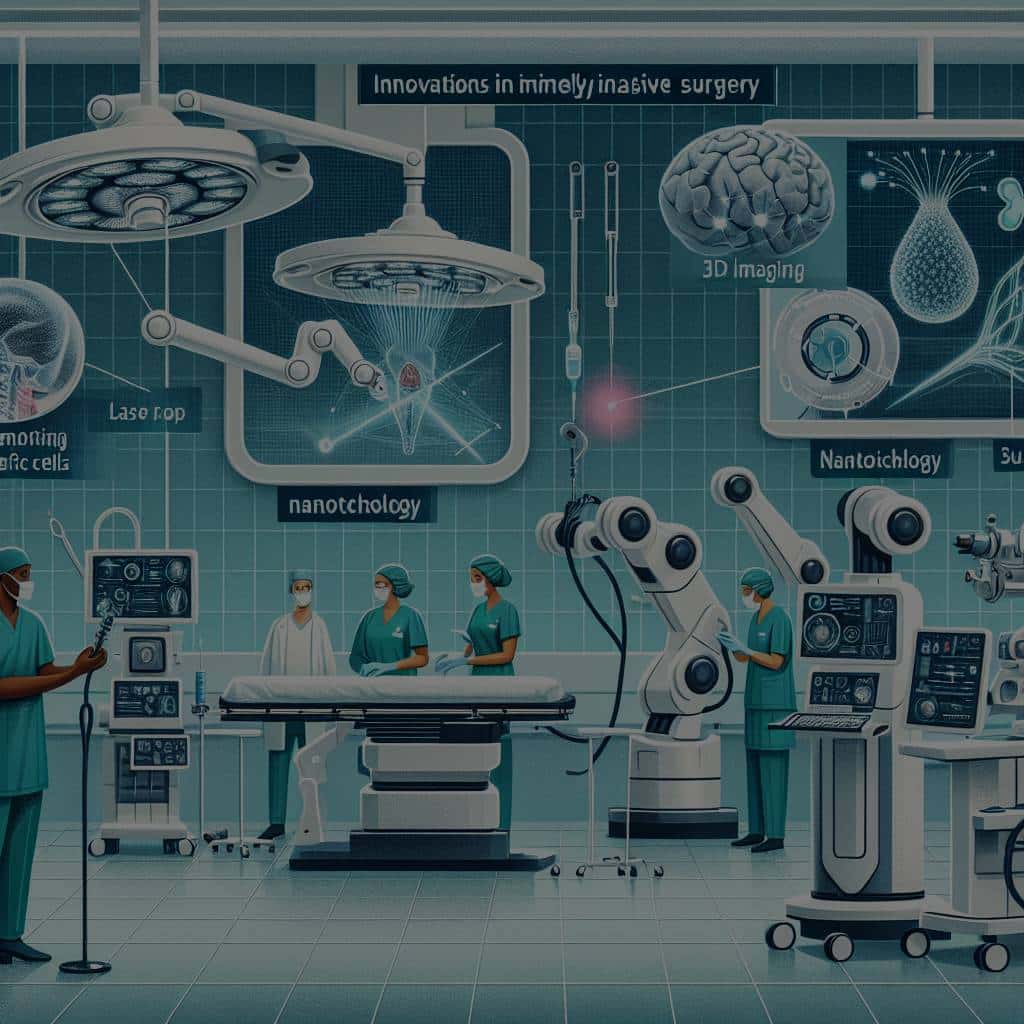What Innovations Are There in Minimally Invasive Surgery for UK Hospitals?

The world of medicine is continually evolving, and innovative surgical techniques are at the forefront of this evolution. Particularly in the United Kingdom, hospitals have adopted some of the most advanced procedures in minimally invasive surgery. This type of surgery is a promotion of patient comfort and quicker recovery times, featuring small incisions as opposed to the traditional open surgeries that often require a lengthy hospital stay and prolonged healing. This article delves into the innovative developments UK hospitals have implemented, focusing on how the NHS, surgeons, and the medical industry at large are harnessing these advancements to improve patient health and care.
Robotic Surgery: The Future of Minimally Invasive Procedures
Robotic surgery is a cutting-edge development in the realm of minimally invasive procedures. This technologically driven method of surgery involves surgeons controlling a robot to perform surgical procedures with high precision. It is a significant step away from traditional surgical methods, as it reduces the physical strain on surgeons and increases their operational precision.
Also to discover : How Does the UK’s Fast Fashion Industry Impact Global Textile Waste?
The use of robotic surgery in the UK has been on the rise, with NHS hospitals leading the way. The da Vinci Surgical System, a pioneer in the field, is already in use in several UK hospitals, providing surgeons with a high-definition, 3D view of their operating field and unparalleled precision. This system allows surgeons to perform complex procedures through tiny incisions, leading to less trauma for the patient and faster recovery times.
Training for robotic surgery is also gaining traction within the NHS. Teaching hospitals offer comprehensive robotic surgery courses, ensuring that the next generation of surgeons is well-equipped to handle this advanced technology.
This might interest you : How Are British Filmmakers Using Virtual Production to Create Immersive Movies?
Data-Driven Care for Improved Patient Outcomes
The use of data in healthcare isn’t new. However, the sheer volume of data available today, coupled with sophisticated analytical tools, has created a shift in how data is used to improve patient care. In the realm of minimally invasive surgery, this translates into more precise pre-operative planning, real-time surgical guidance, and predictive analytics for post-operative care.
Data-driven care involves the continuous analysis of patient health data before, during, and after surgery. This enables surgeons to anticipate potential complications, choose the best surgical approach, and provide personalized post-operative care. The use of predictive analytics in post-operative care means that potential health problems can be identified and managed before they become serious issues, leading to better patient outcomes.
Several UK hospitals are adopting data-driven care, incorporating electronic health records, imaging data, and wearable technology to gather and analyze patient data. This use of technology and data analysis is changing the field of minimally invasive surgery, providing the opportunity for an even more personalized patient care approach.
Innovations in Surgical Training
Minimally invasive surgery requires a unique set of skills and expertise. The rising demand for these types of procedures has necessitated changes in surgical training, with a focus on simulation-based training and virtual reality (VR).
Simulation-based training allows trainee surgeons to practice minimally invasive procedures in a controlled environment, using lifelike models or computer simulations. This gives them the opportunity to hone their skills before they perform these procedures on actual patients. Training institutions, such as the Royal College of Surgeons, have implemented simulation-based training programs as part of their curricula.
Virtual reality, on the other hand, offers an immersive training experience, recreating the operating theatre environment. With VR, trainees can practice procedures in a virtual space, gaining exposure to a variety of scenarios and complications that could arise during surgery, and learning how to manage them.
Harnessing AI in Minimally Invasive Surgery
Artificial intelligence (AI) has permeated every aspect of modern life, and healthcare is no exception. In the field of minimally invasive surgery, AI can be used to assist with pre-operative planning, provide real-time guidance during surgery, and even predict patient outcomes.
Several UK hospitals are using AI in surgery, incorporating machine learning algorithms to analyze patient data and provide personalized care plans. For instance, AI can analyze a patient’s imaging data to suggest the best surgical approach, reducing the risk of complications.
During surgery, AI can provide real-time guidance, assisting surgeons in navigating the surgical field and avoiding critical structures. Post-operatively, AI can be used to monitor patient recovery and predict potential complications, allowing for early intervention.
The Role of 3D Printing in Surgical Innovation
3D printing technology has revolutionized many industries, including healthcare. In the realm of minimally invasive surgery, 3D printing can be used to create patient-specific models for surgical planning, custom surgical tools, and even bioprinted tissues and organs.
Patient-specific models allow surgeons to visualize and plan the surgical procedure in advance, improving surgical precision and reducing the risk of complications. Custom surgical tools can be designed and printed to suit the unique anatomy of each patient, improving the efficacy of minimally invasive procedures.
Bioprinting, although still in its early stages, holds the promise of creating patient-specific tissues and organs for transplantation. This could potentially eliminate the need for organ donors and reduce the risk of transplant rejection.
In the UK, several hospitals and research institutions are exploring the potentials of 3D printing in surgery. The NHS has been proactive in adopting this technology, with several hospitals already using 3D printing for surgical planning and custom tool creation.
The Impact of Robotic-Assisted Surgery
The impact of robotic-assisted surgery cannot be underestimated in the realm of minimally invasive procedures. These advanced systems enhance the surgeon’s ability to perform complex surgeries through smaller incisions. The robots, controlled by the surgeon, can perform intricate movements with a precision that exceeds human capabilities. They offer significant advantages, including improved vision, precision, and control. This results in less damage to healthy tissue, less pain and scarring for patients, and faster recovery times.
In the UK, one of the most widely used robotic surgery systems is the da Vinci Surgical System. This system offers a 3D high-definition view of the patient’s body and allows surgeons to perform precise, controlled movements. Additionally, the da Vinci system provides surgeons with the ability to scale their movements, enabling fine control during delicate procedures.
Robotic-assisted surgery has been adopted in a variety of surgical fields in the UK, including urology, gynaecology, and general surgery. At the forefront of this technological adoption is the Imperial College London, which has been a key player in training surgeons on the use of robotic systems. This has resulted in a broader acceptance and utilisation of robotic systems in the NHS supply chain, ultimately improving patient outcomes and enhancing surgical innovation.
The Promise of 3D Printing in Minimally Invasive Surgery
The use of 3D printing in surgery represents another significant innovation in minimally invasive procedures. This technology provides surgeons with the ability to create patient-specific models of organs or body parts, which can be used for planning and practicing surgeries. This technique is especially useful in complex surgeries, where precise planning can significantly reduce operation times and improve outcomes.
Moreover, 3D printing technology allows for the creation of custom surgical tools tailored to the patient’s unique anatomy. This can enhance the precision and efficacy of minimally invasive procedures. Furthermore, the advent of bio-printing promises the potential of creating functional organs for transplantation, eliminating the need for organ donors and reducing transplant rejection risks.
Several UK hospitals and institutions like the Royal College of Surgeons and the Imperial College London are pioneering the use of 3D printing in surgical applications. This innovative approach is rapidly transforming the landscape of surgical care in the UK, making surgeries safer, more precise, and less invasive.
Conclusion
The landscape of minimally invasive surgery in the UK is evolving at a rapid pace, with new technological advancements continually emerging. These innovations, including robotic surgery, data-driven care, simulation-based training, artificial intelligence, and 3D printing, are revolutionising surgical care. They are enabling surgeons to perform complex procedures with greater precision and control, leading to improved patient outcomes.
The adoption of these technologies within the NHS supply chain and the commitment to training health care professionals in their use will continue to drive the success of minimally invasive surgery in the UK. This forward-thinking approach to surgical innovation ensures that the UK remains at the forefront of global advancements in health care. These technologies are not only improving the quality of surgical care but are also shaping the future of medicine as we know it.
As these innovations continue to evolve and mature, they will undoubtedly play an integral role in shaping the future of minimally invasive surgery in the UK and beyond. The promise they hold is immense and we are just at the beginning of this exciting journey. The future of surgery is minimally invasive, and it is here.
